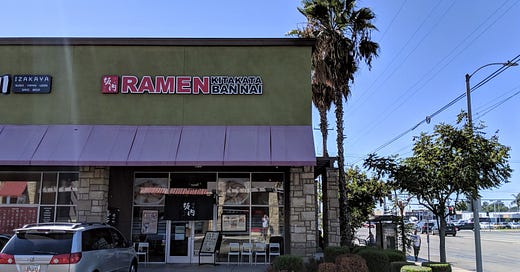喜多方ラーメン Kitakata Ramen Ban Nai
🇯🇵 JAPAN / HISTORICAL: Always the third of the "Big 3" ramens, this shoyu style is ready to shine at various locations throughout Southern California.
🇯🇵 JAPAN
📍 Multiple Locations
7550 Orangethorpe Avenue,
Buena Park, Orange County.
🅿️ Varies by location
🥤 Beer and sakeHISTORICAL ARTICLES are brought over from eattheworldla.com to make sure our Substack content is constantly growing and as full of depth as possible. These will never be behind the paywall.
📆 Original Article 15 January 2019When talking about "Big 3" regional styles of ramen, most people outside of Japan have heard of Hakata and Sapporo styles, both having evolved from large metropolitan areas with many vendors and varieties. But a third lesser known style was developed in northern Honshu in the small village of Kitakata which gives it its name. Known for its storehouses full of soy sauce, Kitakata-style ramen uses this as its base, a type of shoyu.
The bowl itself appears simple, a broth full of noodles and topped with chashu and some thinly sliced spring onion, but do not let this fool you. This broth has been extracting pure umami from pork bones for "long hours" which gives it an almost smoky and toasted taste, full of earth and charcoal.
Ban Nai is the most famous source of this style of ramen, with 62 locations around Japan. Here in the United States there are now two in Orange County, California (the other is in Costa Mesa), one outside of Chicago, and one in Jersey City, NJ.
The broth of their standard Kitakata ramen ($13.95, above and below) is already full of flavor, but the chashu is a flavor bomb. Some might call this salty but their "secret recipe" marinade is wonderful, the pork belly is definitely its own product and not just full of taste from the bowl. For an upcharge to $12.50 you can get a bowl completely covered at the top with chashu (see plastic model below).
The noodles of Kitakata ramen are thick, curly, and chewy as seen above. More water than usual is used in these to give it the soft texture and they are hand-crumpled for the waviness. This character seems to be perfect for the interaction it has with the broth.
🇯🇵🇯🇵🇯🇵








